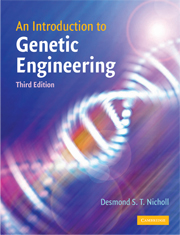Book contents
- Frontmatter
- Contents
- Preface to the third edition
- An Introduction to Genetic Engineering
- Chapter 1 Introduction
- Part I The basis of genetic engineering
- Part II The methodology of gene manipulation
- Part III Genetic engineering in action
- Suggestions for further reading
- Using the World Wide Web
- Glossary
- Index
Preface to the third edition
- Frontmatter
- Contents
- Preface to the third edition
- An Introduction to Genetic Engineering
- Chapter 1 Introduction
- Part I The basis of genetic engineering
- Part II The methodology of gene manipulation
- Part III Genetic engineering in action
- Suggestions for further reading
- Using the World Wide Web
- Glossary
- Index
Summary
As I found when preparing the second edition of this text, advances in genetics continue to be made at an ever increasing rate, which presents something of a dilemma when writing an introductory text on the subject. In the years since the second edition was published, many new applications of gene manipulation technology have been developed, covering an increasingly diverse range of disciplines and applications. The temptation in preparing this third edition, as was the case for its predecessor, was to concentrate on the applications and ignore the fundamental principles of the technology. However, in initial preparation I was convinced that a basic technical introduction to the subject should remain the major focus of the text. Thus, some of the original methods used in gene manipulation have been kept as examples of how the technology developed, even though some of these have become little used or even obsolete. From the educational point of view, this should help the reader cope with more advanced information about the subject, as a sound grasp of the basic principles is an important part of any introduction to genetic engineering. I have again been gratified by the many positive comments about the second edition, and I hope that this new edition continues to serve a useful purpose as part of the introductory literature on this fascinating subject.
In trying to strike a balance between the methodology and the applications of gene manipulation, I have retained the division of the text into three sections.
Information
- Type
- Chapter
- Information
- An Introduction to Genetic Engineering , pp. xi - xiiPublisher: Cambridge University PressPrint publication year: 2008
